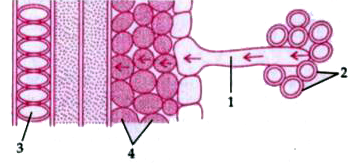In Trapa some of the roots are
Aerial
Assimilatory
Respiratory
Floating
The correct Answer is:B
To answer the question "In Trapa, some of the roots are," we will analyze the characteristics of the roots in the Trapa plant, which is an aquatic plant. Here’s a step-by-step solution:
Step 1: Identify the Plant Type
Trapa is an aquatic plant, which means it grows in water bodies.
Hint: Consider the habitat of the plant when determining the characteristics of its roots.
Step 2: Understand Root Functions
Roots in plants can serve various functions including anchoring the plant, absorbing water and nutrients, and in some cases, performing photosynthesis.
Hint: Think about how aquatic plants might adapt their roots for survival in water.
Step 3: Analyze the Options
1. Aerial Roots: These roots are typically found in plants that grow above ground and are not characteristic of Trapa.
2. Assimilatory Roots: These roots can perform photosynthesis, which is a function that Trapa roots can do.
3. Respiratory Roots: These are specialized roots for gas exchange, which are not present in Trapa.
4. Floating Roots: While Trapa does have floating structures, the question specifically asks about roots.
Hint: Eliminate options that do not match the characteristics of Trapa.
Step 4: Conclusion
Based on the analysis, the correct answer is that in Trapa, some of the roots are Assimilatory roots, as they can perform photosynthesis.
Final Answer: The correct option is Assimilatory (Option 2).
Trapa is an aquatic plant, which means it grows in water bodies.
Roots in plants can serve various functions including anchoring the plant, absorbing water and nutrients, and in some cases, performing photosynthesis.
1. Aerial Roots: These roots are typically found in plants that grow above ground and are not characteristic of Trapa.
2. Assimilatory Roots: These roots can perform photosynthesis, which is a function that Trapa roots can do.
3. Respiratory Roots: These are specialized roots for gas exchange, which are not present in Trapa.
4. Floating Roots: While Trapa does have floating structures, the question specifically asks about roots.
Based on the analysis, the correct answer is that in Trapa, some of the roots are Assimilatory roots, as they can perform photosynthesis.
Topper's Solved these Questions
- ROOTBOOK - DINESH PUBLICATION ENGLISHCHAPTER - ROOTEXERCISE - REVISION QUSTIONS FROM COMPETITIVE EXAMS.
52 Videos
- ROOTBOOK - DINESH PUBLICATION ENGLISHCHAPTER - ROOTEXERCISE - Assertion
2 Videos
- RESPIRATIONBOOK - DINESH PUBLICATION ENGLISHCHAPTER - RESPIRATIONEXERCISE - CHECK YOUR GRASP
20 Videos
- SEEDSBOOK - DINESH PUBLICATION ENGLISHCHAPTER - SEEDSEXERCISE - CHECK YOUR GRASP
10 Videos
Similar Questions
The figure given below is a diagrammatic representation of a part of the cross-section of the root in the root hair zone. Study the same and then answer the questions that follow :

Draw a labelled diagram of the root hair cell as it would appear if some fertilizer is added to the soil close to it.
View SolutionIf α,β are the roots of ax2+bx+c=0,(a≠0) and α+δ,β+δ are the roots of Ax2+Bx+C=0,(A≠0) for some constant δ then prove that b2−4aca2=B2−4ACA2
View SolutionThick unbranched roots found in corms and rhizomes of some plants are
View SolutionA root of unity is a complex number that is a solution to the equation, zn=1 for some positive integer nNumber of roots of unity that are also the roots of the equation z2+az+b=0, for some integer a and b is
View SolutionSelect the correct statements
(A) From the region of elongation, some of the epidermal cell for root hairs
(B) Pneumatophores are seen in Rhizophora
(C) Adventitous roots are seen in the Banyan tree
(D) Maize and sugarcane have prop roots
View SolutionArrange the various regions of the root starting from the root tip / root cap
View SolutionThe figure given below is a diagrammatic representation of a part of the cross section of the root in the root hair zone. Study the same and then answer the questions that follow :

Due to an excess of this pressure sometimes drops of water are found along the leaf margins of some plants especially in the early mornings. What is the phenomenon called ?
View SolutionMain root of tap root system represents
View SolutionSupporting roots of maize stem, which arise from the lower nodes are called
(a) Pneumatophores
(b) Prop roots
(c) Stilt roots
(d) Contractile roots
View SolutionAssertion: Photosynthesis roots are a type of Tap Root System.
Reason: Anoxygenic photosynthesis is performed by photosynthetic roots.
View Solution
